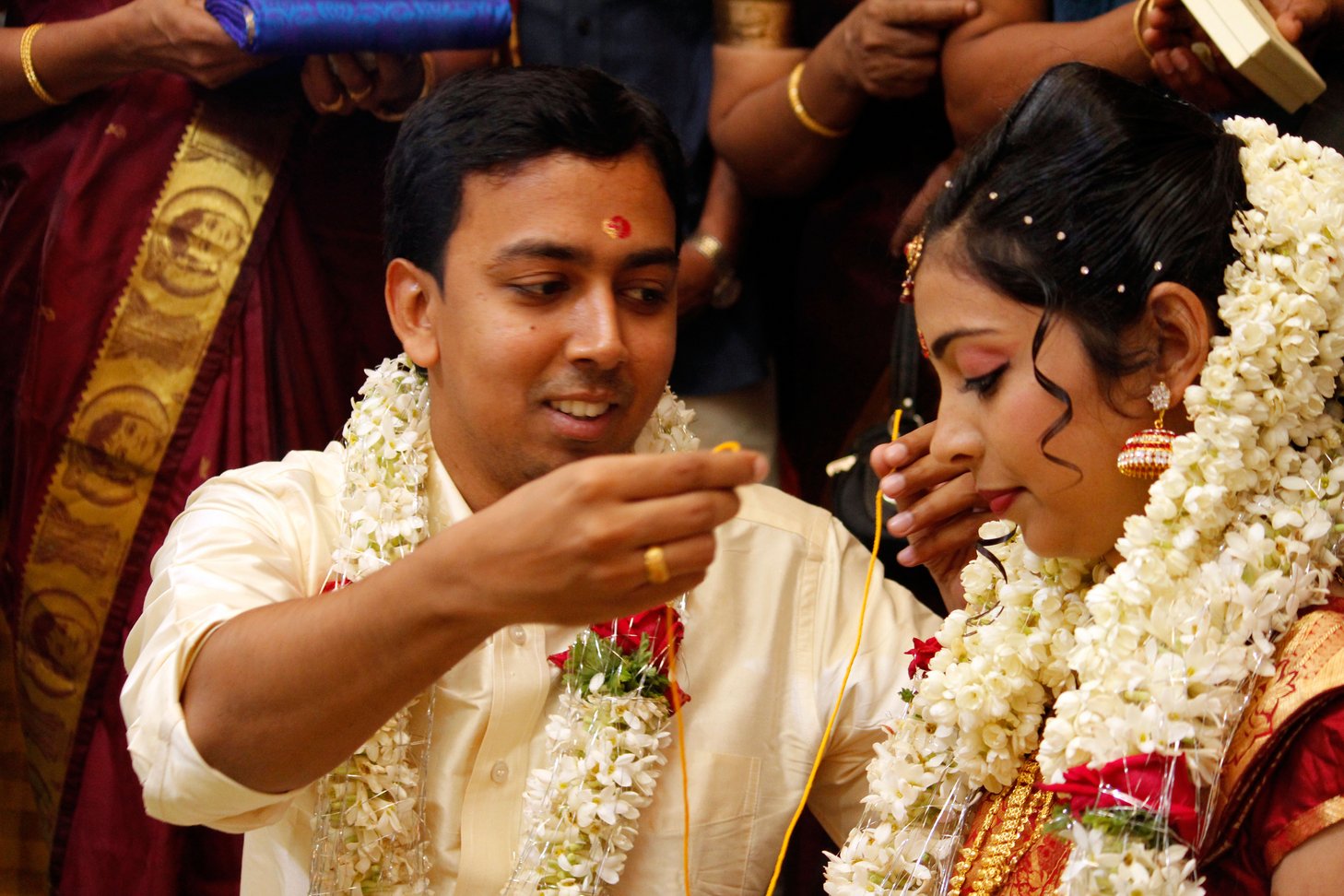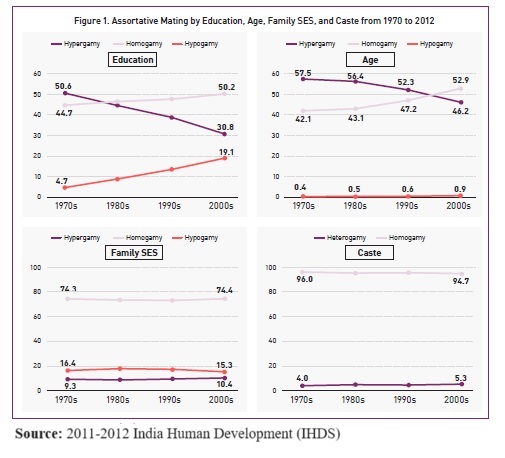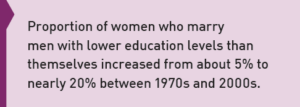
Photo Credit: Alamy
The expansion of women’s education globally has brought about significant changes in the dynamics of the marriage market and assortative mating patterns (Van Bavel et al. 2018). In India, the trends in educational assortative mating align with the global experience in some aspects while deviating in others. As expected, the expansion of women’s education in India has reduced the incidence of hypergamy, where women marry men with higher education. There has been, in fact, a notable increase in hypogamy, where women marry men with lower education levels.
 To gain a deeper understanding of these trends, our study (Lin et al. 2020) draws upon data from the India Human Development Survey (IHDS) conducted in 2011-2012. This nationally representative survey provides valuable insights into the evolving patterns of spousal educational differences in India. By examining recent marriage cohorts, we can explore how educational hypogamy has evolved over time. Figure 1 shows changes in the assortative mating patterns by education, age, family socioeconomic status (SES), and caste for Indian marriages between 1970 and 2012. Although the rise in hypogamy might suggest a more egalitarian and flexible approach to marriage in India, a closer look at the data reveals that other boundaries, typical of a patriarchal society, remain rigid. Marrying younger men, inter-caste marriages, and unions with men from lower economic backgrounds are still uncommon. This indicates that despite educational hypogamy, the broader norms of gender inequality persist (Allendorf and Pandian 2016).
To gain a deeper understanding of these trends, our study (Lin et al. 2020) draws upon data from the India Human Development Survey (IHDS) conducted in 2011-2012. This nationally representative survey provides valuable insights into the evolving patterns of spousal educational differences in India. By examining recent marriage cohorts, we can explore how educational hypogamy has evolved over time. Figure 1 shows changes in the assortative mating patterns by education, age, family socioeconomic status (SES), and caste for Indian marriages between 1970 and 2012. Although the rise in hypogamy might suggest a more egalitarian and flexible approach to marriage in India, a closer look at the data reveals that other boundaries, typical of a patriarchal society, remain rigid. Marrying younger men, inter-caste marriages, and unions with men from lower economic backgrounds are still uncommon. This indicates that despite educational hypogamy, the broader norms of gender inequality persist (Allendorf and Pandian 2016).
Our study shows that the increase in educational hypogamy can be attributed to several factors. First, the expansion of education has led to improvements in educational attainment for both men and women, along with a reduction in the gender gap over time. However, economic resources seem to play a more significant role than education credentials in mate selection. Women with higher education levels who marry down in terms of educational matching are more likely to come from families with lower economic status compared to their husbands’ families. This highlights the importance of economic considerations in marriage decisions (Prakash and Singh 2014).
 Furthermore, our analysis reveals that women majoring in fields associated with poorer labor market outcomes in India, such as humanities and social sciences, are increasingly involved in hypogamous marriages. This reflects the uneven distribution of educational returns in the labor market, particularly for women in transitional economies. Despite the expansion of education, female labor force participation in India remains low, even among those with college degrees (Chatterjee et al. 2018). This disparity prevents women who marry down in terms of educational attainment from achieving economic parity with their husbands.
Furthermore, our analysis reveals that women majoring in fields associated with poorer labor market outcomes in India, such as humanities and social sciences, are increasingly involved in hypogamous marriages. This reflects the uneven distribution of educational returns in the labor market, particularly for women in transitional economies. Despite the expansion of education, female labor force participation in India remains low, even among those with college degrees (Chatterjee et al. 2018). This disparity prevents women who marry down in terms of educational attainment from achieving economic parity with their husbands.
In addition to socioeconomic status, other social boundaries unique to the Indian context contribute to the likelihood of educational hypogamy. Our analysis suggests a positive association between consanguineous marriages (within the family) and hypogamy, particularly in regions where intra-family marriages are prevalent due to limited eligible partners outside the family. Moreover, the availability of eligible men with higher secondary education negatively impacts the odds of educational hypogamy. In areas with a scarcity of eligible men, marrying down in terms of education may become a woman’s only option in a society where universal marriage is the norm.
The IHDS data provide valuable insights into the complexities of educational assortative mating in India. It highlights the need to consider not only educational attainment but also factors such as economic resources, cultural norms, and social boundaries when analyzing marriage patterns. The rise in educational hypogamy in India does not signify a breakdown of gender barriers or a promising shift in gender norms. Instead, it reflects the intricate interplay of various factors in the Indian society.
While the expansion of women’s education is a significant step toward gender equality, it is important to address the underlying structural barriers that hinder the translation of educational advantages into economic gains. Achieving true gender equality in marriage and society requires a comprehensive approach that tackles these challenges. The IHDS data serve as a valuable resource for researchers and policymakers seeking to understand and address the complexities of educational assortative mating in India, ultimately fostering greater gender equality and empowerment.
References:
Allendorf, K., & Pandian, R. K. (2016). The decline of arranged marriage? Marital change and continuity in India. Population and Development Review, 42(3), 435–464.
Chatterjee, E., Desai, S., & Vanneman, R. (2018). Indian paradox: Rising education, declining women’s employment. Demographic Research, 38, 855–878.
Lin, Z., Desai, S., & Chen, F. (2020). The emergence of educational hypogamy in India. Demography, 57, 1215–1240.
Prakash, R., & Singh, A. (2014). Who marries whom? Changing mate selection preferences in urban India and emerging implications on social institutions. Population Research and Policy Review, 33(2), 205–227.
Van Bavel, J., Schwartz, C., & Esteve, A. (2018). The reversal of the gender gap in education and its consequences for family life. Annual Review of Sociology, 44, 341–360.
Zhiyong Lin is an Assistant Professor of Sociology at the University of Texas at San Antonio and a Faculty Affiliate in the Population Research Center at the University of Texas at Austin. One line of his research consists of social determinants of well-being, mostly among older adults. The other strand of his research investigates the changing patterns of romantic relationships in diverse social contexts undergoing dramatic transitions. His work is published in Demography, Social Forces, Journals of Gerontology: Social Sciences, Journal of Health and Social Behavior, Demographic Research, and other peer-reviewed outlets.